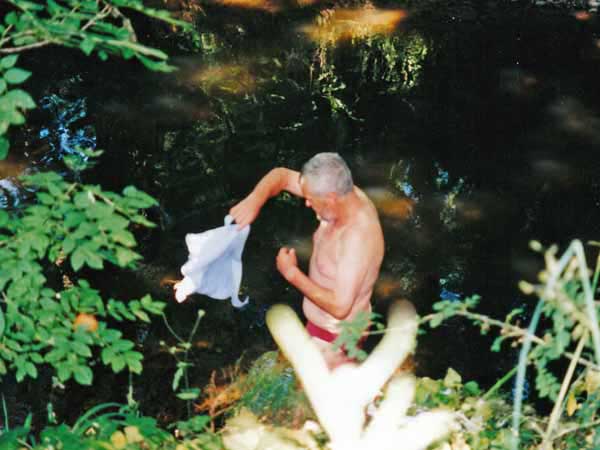Wednesday, 28 May 2003
Distance 25 km
Duration 5 hours 50 minutes
Ascent 522 m, descent 520 m
Map 48 of the TOP100 blue series (now superseded)

Our starting time is improving – we managed 7:30 this morning.
We took a back road to Félines, with its charming church and graveyard, then a short sharp climb to the crest of the hill where the great bulk of Castelnau sits.
We first saw it as a jagged distant shape, over a day ago. Up close it is intimidating, or would have been in the time of the seigneurs.
There is a whole village inside the walls, as well as the château.

Here we joined the GR652 going downhill on a stony lane. The fields below Castelnau, newly ploughed, had the purplish bloom of a plum. There were orchards, market gardens and a goose farm.
When we reached the stream we met a man staring into the water, looking for fish, he said.
Having found out that we were Australian, he asked why on earth we wanted to come to such an ordinary place as France, from our exotic homeland. I said we were walking to Spain, which impressed him.

Leaving the tree-shaded stream, we crossed a road, skirted a flower farm and arrived abruptly in Autoire.
This is a little Quercy gem, with its own modest château and several circular houses, including a tall pigeonnier, with the characteristic flaring rooflines of the local style.
Best of all, the bar at the hotel was just opening. The woman stopped mopping the floor and prepared glorious coffees for us, which we took on the terrace with our boots off.
The next leg was more of a climb than a walk, up the escarpment to the causse. There were many limestone outcrops, chalky white, to be scrambled up, and even a couple of metal ladders.

Once on the causse it was virtually flat, with stunted oak forest and dry fields. The path was ancient, bordered with lichen-encrusted limestone walls.
Before long we came to the village of Loubressac on its bluff overlooking the distant river. The midday bells were ringing as we sat down in the little central park for lunch.

Afterwards we had more coffee outside the nearby restaurant and experienced the strange sense of humour of the French air force. Two fighters shot over our heads at about tree height, with a shattering scream. They love these hilltop villages.
Plunging down the other side, we were soon on a small rural road, which turned into a steep woodland path down to the river.
Here we had the choice of climbing again on the GR, or taking to the road beside the water. We unanimously decided on the latter.

Luckily, the small amount of traffic was mostly bikes, and we could walk on the bitumen, as there was no verge.
When we came to the camping ground, with no sign of the town, we left Penny there to mind the packs and trudged on a couple more kilometres to Carennac.
We needed lunch supplies and something for Penny to eat tonight, as she was too exhausted to go to a restaurant.
This was our third Plus Beau Village for the day (Autoire and Loubressac being the others), but we had trouble finding a shop. When we finally did, it was shut, despite the listed opening hours.

I cupped my hands on the grimy window to peer in, and found myself eyeball to eyeball with the stony-faced grocer, peering out. We were still standing there a minute later, trying to decide what to do, when the latch clicked.
Nobody was in sight when we went in, but as we were choosing a few things, a figure slid out of the shadows and watched bleakly. Perhaps he was a very shy man in the wrong job. Only when I said we were walking to Rocamadour did he manage a smile.

Back at the camping, Penny had not seen a soul and said that the place had no ablution blocks. They seemed to be still under construction. Undaunted, we put up our tents and bathed in the cool waters of the Dordogne.
Leaving Penny with her duck leg and lettuce, we set off again for town, this time in sandals, and dined in an old-fashioned travellers’ inn, with doors open to the river. The huge fireplace and wood panelling were a reminder of the comforts of winter in these parts.

We had a salad with warm duck ham to begin, liberally accompanied by bread, which the waitress cut with a guilloutine in an unnecessarily gruesome way, given French history.
Then we had an omelette, a steak and a crème brûlée, all excellent, washed down with the usual half-litre of red.
Previous day: Beaulieu to Bretenoux